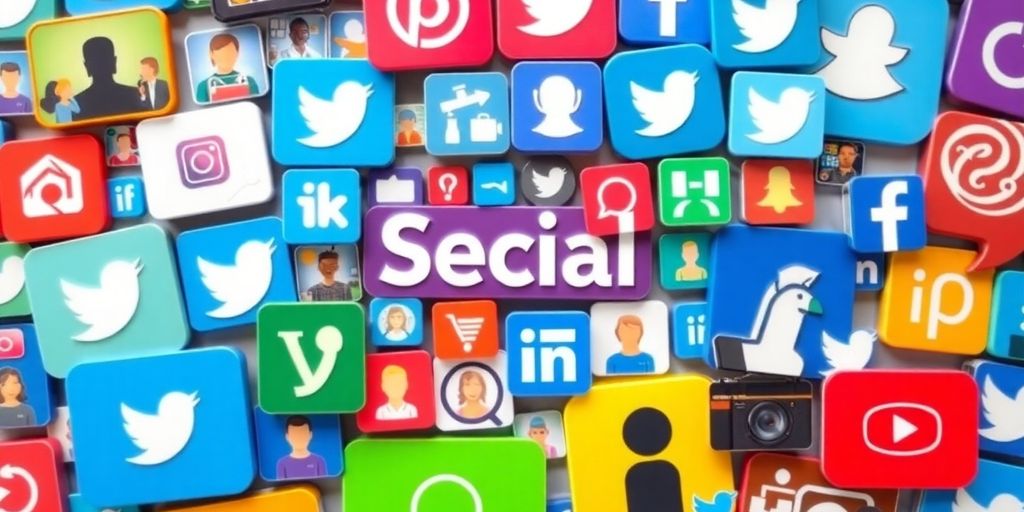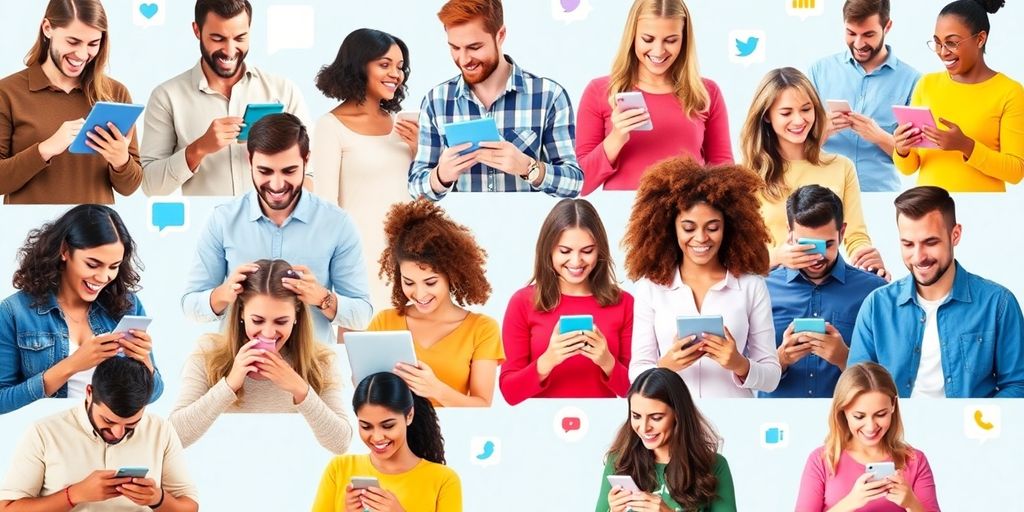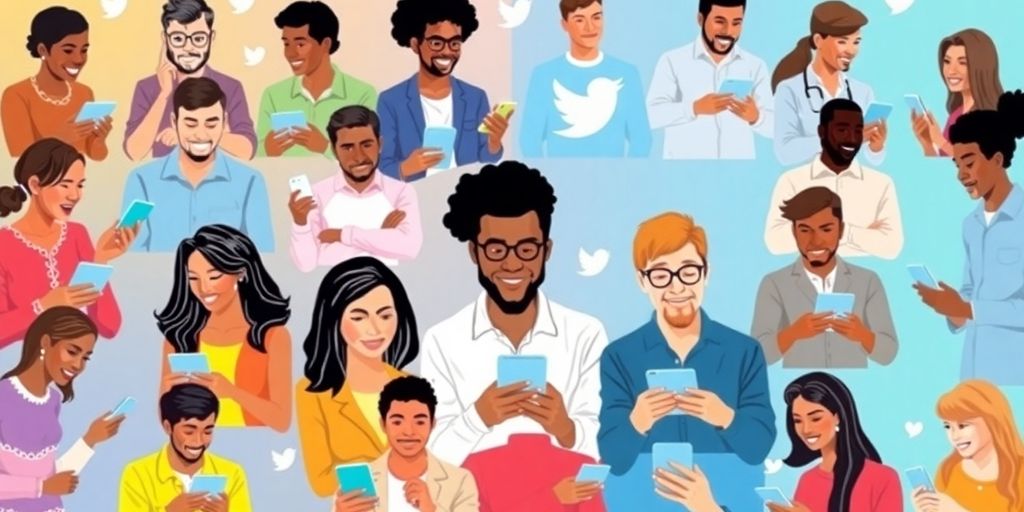Social media has changed the way we communicate and interact with each other. From the early days of simple text posts to today's vibrant multimedia content, the evolution of social media platforms has significantly impacted modern communication. This article will explore how these changes have shaped our relationships, influenced marketing strategies, and even sparked social movements, all while focusing on the role of video in this transformation.
Key Takeaways
- Social media has transformed personal connections, making it easier to stay in touch regardless of distance.
- The shift from traditional to digital communication has broadened access to information and changed how we share news.
- Visual content, especially videos, plays a crucial role in engaging audiences and conveying messages effectively.
- Influencers have become key players in marketing, helping brands build trust and authenticity with consumers.
- Social media serves as a powerful platform for social change, amplifying voices and movements that may not have been heard otherwise.
The Evolution of Communication through Social Media Platforms
Redefining Interpersonal Connections
Social media has really changed the way we connect. People now share what’s going on in their lives with quick updates rather than long, drawn-out conversations. Instead of meeting face-to-face all the time, we’re constantly posting, commenting, and reacting. This shift lets us stay in touch even when we’re far apart. For example, similar approaches are used in church strategies that help communities feel closer, even on busy days.
The Shift from Traditional to Digital Media
Back in the day, communication meant writing letters or making a phone call. Today, a single text or post can reach someone instantly. Digital communication reshaped our daily interactions and brought a new kind of pace to our lives. Here’s a quick look at how things compare now versus before:
This table shows how drastically the tools we use have changed and the impact on our everyday life.
Global Reach and Instant Access
The internet has turned our small talks into global conversations. No matter where someone is, they can be part of a larger community in seconds. This worldwide access has transformed our news, our opinions, and even the way we share personal stories.
- Real-time updates let you catch events as they happen.
- News and opinions spread quickly across continents.
- Online communities form around nearly every interest imaginable.
It’s impressive how quickly information travels around the world these days. Every post acts as a small ripple connecting different communities, cultures, and ideas.
In this new era of communication, social media not only keeps us in touch but also gives us a way to share experiences without borders. It might feel a bit overwhelming at times, but it also creates countless new opportunities for connection.
The Power of Multimedia Content on Social Media

Enhancing Engagement through Visuals
Scrolling through your feed, it's obvious that strong visuals capture your attention faster. Photos and graphics turn complex messages into simple, quick snapshots, making it easier to connect with the content. Here are a few reasons why visuals work so well:
- They grab you immediately, even during a quick scroll.
- They simplify information that might take paragraphs to explain in text.
- They stick in your mind longer than plain words.
Think of visuals as a shortcut to making ideas instantly clear. When local groups, like church outreach, use these elements, they see better engagement and more people joining in the conversation.
The Rise of Video Content
Videos are shaping the way we share and absorb information online. Instead of sitting through endless text, we now get quick clips and live streams that make messages feel more personal. Consider these points:
- Videos deliver updates and moments in real time.
- They offer a behind-the-scenes look that builds a stronger connection.
- They can present emotions and stories in a way that static images just can't match.
Anyone who’s watched a live social media video knows the impact. Whether you're catching updates from a neighborhood event or tuning into a local church’s live session, the power of video is hard to ignore, much like when you check out a quick live chat update.
Storytelling through Images and Clips
Combining images with short clips gives storytellers a natural way to express what words alone can't. This combo helps share everyday moments that feel genuine and relatable. Here’s why this mix is effective:
- An image can instantly set a mood or highlight a key point.
- A brief clip can capture a fleeting yet memorable moment.
- Together, they spark conversations that text posts might not start.
This approach is increasingly popular among community groups and even places of worship. They use both photos and videos to connect with audiences on a personal level, much like sharing community care stories during regular updates.
Bringing your story to life through visuals isn’t just about looking good—it’s about making a genuine connection with your audience. It’s a friendly invitation to see the world through someone else’s eyes.
The Role of Influencers in Modern Communication
Building Trust and Authenticity
Influencers have changed the way we think about connection. They share everyday stories that make us feel like we’re chatting with a friend. By being honest and showing real experiences, they build trust. Many people feel more connected when an influencer blends their personal life with their opinions. For example, influencers using church software often stress that being genuine matters more than perfect images.
Here are a few ways influencers build that trust:
- Sharing authentic, everyday moments
- Interacting honestly with followers
- Showing consistent and relatable content
Sometimes, all it takes is a simple, unpolished story to remind us that we’re not alone in this digital world.
The Impact of Influencer Marketing
Influencer marketing has shifted the way messages reach us. Instead of traditional adverts, influencers make recommendations that feel like a chat with a buddy. Influencer marketing can turn everyday messages into genuine conversations. This method not only grabs our attention but also often leads to a positive buzz about a product or service.
Below is a quick look at some common metrics seen in influencer marketing campaigns:
By using an effective strategy, brands can mix sponsored posts with organic content to feel less like an ad and more like a helpful suggestion.
Navigating Brand Collaborations
Working together with brands can be a bit of a balancing act. Influencers, brands, and audiences each bring something unique to the table. This area requires clear communication and shared goals.
A few steps for smooth collaborations include:
- Setting clear and simple goals
- Picking partners who match in style
- Keeping an open and steady dialogue during projects
By keeping things straightforward, both sides can enjoy the process and make campaigns feel natural rather than forced.
Social Media as a Tool for Social Change
Social media is more than just a way to chat with friends—it has become a stage for change and a meeting ground for new ideas. It gives everyone a way to speak up, and when things pile up, it shows that change can start with just a simple post.
Grassroots Movements and Activism
Many local groups have used social media to kick off important causes. This isn’t just about online buzz; it’s a real way for people to come together on issues that affect their everyday lives. A few basics include:
- Organizing local meetups to talk through problems
- Using live sessions and stories to share real events
- Creating simple videos that spur viewers into action
Sometimes, everyday posts turn into powerful calls to change. A single tweet can mobilize a community. Also, groups like young church members have seen this in action as they rally behind issues they care about.
Amplifying Marginalized Voices
Social platforms let voices that often go unheard rise above the noise. This new online stage gives small communities a chance to share their views without being drowned out by big media. Before social media, many voices stayed on the sidelines; now, everyone has a space to speak.
Here’s a quick look at how this plays out:
This table is a simple reminder that the impact is not the same everywhere, but it is there nonetheless. Tools provided by church tools show that even structured environments can benefit from these open channels.
The Role of Hashtags in Awareness
Hashtags have changed the conversation. They work like mini tags that stick to important ideas. Multiple people can use a hashtag to join the same discussion, which makes finding related posts easier. A few reasons why hashtags are still huge include:
- They group similar topics together
- They make it simple to see trends in a flash
- They allow anyone to push a topic into the spotlight
When you see a trending hashtag, it tells you that many people are looking at the same problem or idea, and sometimes that shared focus can turn into real change.
In the end, social media brings raw, unfiltered voices into our screens. It keeps the conversation running in communities far and wide.
The Future of Video Content in Social Media
Emerging Trends in Video Sharing
The way we share video is clearly changing. New video styles keep popping up, and it's a mix of fun and a bit of learning. Platforms are not sticking to one kind of video anymore: you see live streams, immersive clips, and even stuff with interactive links. Video content is changing fast and it's more than just a trend.
Here’s a quick look at some trends in numbers:
Live Streaming and Real-Time Engagement
Live streaming has really bridged the gap between creators and audiences. Instead of waiting for a polished video, people can join a live session and interact on the fly. This immediacy makes interactions feel personal. Here are a few ways live streaming is redefining how we connect:
- Real-time Q&A sessions
- Instant audience feedback
- Direct conversations with hosts
These live sessions can be a bit messy sometimes, but that rawness is what makes them engaging.
The Importance of Short-Form Videos
Short clips are here to stay. They’re quick, snappy, and easy to digest, which suits our busy lifestyles. Whether it's a funny moment, a quick tip, or a dramatic announcement, short videos pack a punch. They are preferred especially on platforms where viewers expect fast content.
Some points to note about short-form videos:
- They grab attention quickly.
- Easy to create and share with friends.
- Perfect for mobile viewing in extra busy moments.
Short-form videos not only capture moments, but they invite viewers into a more spontaneous and unfiltered world, keeping social media lively and unpredictable.
Overall, the future of video content in social media looks exciting. As creators experiment, viewers get more reasons to stay tuned to their favorite platforms, enjoying a mix of planned content and live surprises.
Challenges and Opportunities in Social Media Communication
Social media isn’t just a place for casual updates. It comes with its own set of issues and chances for growth. There are things that can trip us up, and there are ways to make it work for us. Let’s unpack some of these with a few real-life thoughts.
Navigating Misinformation
Fake news, rumors, and half-truths can spread like wildfire online. It’s a bit of a maze trying to find what’s real these days. One way to make sense of it is to keep a few ideas in mind:
- Check multiple sources before accepting information as true.
- Ask questions and look for evidence if a claim seems off.
- Know that even trusted friends can sometimes share things they think are true but might not be.
Using tools like church software for content moderation can help communities spot and debunk false claims. Honesty in sharing matters because what you share can change minds.
Sometimes, when you see a piece of information that sounds too wild to be true, it pays off to step back and ask, ‘Could this really be right?’
Balancing Privacy and Connectivity
Social platforms let us keep in touch, but they also ask for a lot of personal details. It can feel like walking a tightrope. On one hand, sharing helps you connect; on the other, you might wonder who else is watching. Think about it like this:
- Personal details can help create stronger bonds online.
- Oversharing might open doors to issues like data leaks.
- Smart choices and settings help you find a good middle ground.
It’s important to be aware of what you’re giving away, much like managing any sensitive information in real life.
The Impact of Algorithms on Engagement
Algorithms decide a lot about what we see in our feeds. They decide which posts seem interesting and which ones get buried. Here’s a closer look at how this affects us:
- Posts with high engagement tend to show up more often.
- Algorithms can create a bubble where you only see similar points of view.
- Changes in these systems can suddenly shift what trends online.
Below is a simple table showing how different content types might fare with current algorithms:
For those managing online communities, understanding these shifts is key. This structured layout, much like using church software for organized communication, helps keep things clear.
In the end, every challenge in social media has its bright side if you know where to look. Stay curious and informed, and you’ll find ways to make your online experience work for you.
The Psychological Effects of Social Media Interaction

Understanding Online Behavior
Online actions aren’t the same as face-to-face conversations. You might find that people behave differently online—more outspoken or sometimes more reserved. This shift happens because the screen creates a buffer between us. For example, when users engage in heated threads, it’s not unusual to see more extreme views compared to in-person chats. Here are a few points that often come into play:
- People sometimes express stronger emotions when they’re behind a screen.
- Online discussions can become fast and sometimes lose context.
- The anonymity of the internet can both free up genuine thoughts and lead to misunderstandings.
Social media can both connect and divide people in surprising ways.
Additionally, if you’re interested in how these digital behaviors translate to real-world strategies, consider a solid church strategy to merge online and offline interactions for community growth.
The Influence of Likes and Shares
Every tap on a like or share can shift the vibe of a conversation. On one hand, those quick interactions feel like instant validation or support, but on the other, they can also raise expectations about what content should be valued. Let’s break down a few common reactions:
Engagement metrics like these can sometimes steer content creators toward what they think the audience wants, even if it isn’t always the best for genuine conversation.
Mental Health Considerations
Many people today feel overwhelmed by the pace and pressure of constant online interaction. Social media environments can sometimes make us feel isolated, anxious, or even drained. It helps to recognize a few common impacts:
- Too much screen time can leave you feeling worn out.
- Comparison with others’ highlight reels may cause doubt and low self-esteem.
- Constant notifications may interrupt your day and add stress.
It’s important to step back occasionally and reflect on how digital spaces are affecting your mood and mental balance. Taking breaks isn’t a weakness—it’s a way to look after your well-being.
Balancing online activity with real-world moments keeps things in check. Remember, just like planning a good church strategy can help connect communities, monitoring your own digital habits ensures you don’t lose sight of what matters most.
Social media can really change how we feel and think. When we interact online, it can make us feel happy or sad, depending on what we see and how we connect with others. It's important to understand these feelings so we can use social media in a good way. If you want to learn more about how to make the most of your online interactions, visit our website for helpful tips and tools!
Wrapping It Up
So, here we are at the end of our journey through the world of social media and its impact on how we communicate today. It’s pretty wild to think about how far we’ve come, right? From simple text posts to videos that can go viral in minutes, social media has changed the game completely. Sure, there are ups and downs—like the way it can connect us but also sometimes pull us apart. As we keep using these platforms, it’s important to remember to use them wisely. Let’s keep the conversation going, stay informed, and make the most of this powerful tool that keeps us all connected.
Frequently Asked Questions
What is the main focus of the article?
The article looks at how social media has changed communication over time.
How has social media changed personal connections?
Social media allows people to stay in touch easily, no matter where they are.
What types of content are popular on social media?
Visual content like images and videos are very popular, especially for engagement.
What role do influencers play in social media?
Influencers help build trust and connect brands with their audience.
Can social media be a force for social change?
Yes, social media helps raise awareness and supports movements for social change.
What challenges does social media face today?
Challenges include dealing with misinformation and balancing privacy with connection.




